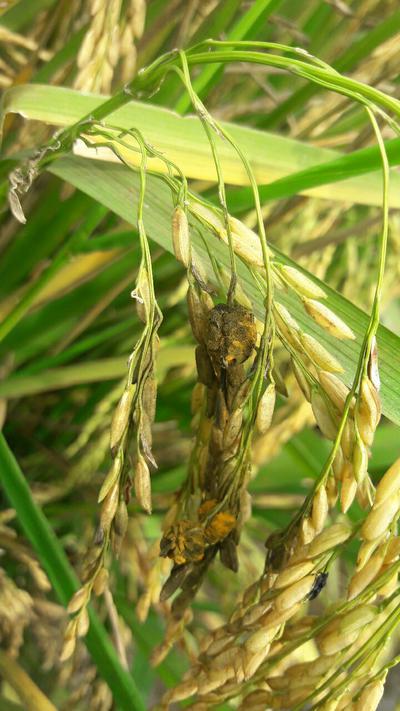False Smut
Villosiclava virens
Fungus
In a Nutshell
- Small orange, smooth ‘balls’ on some rice grains.
- Balls will dry and turn greenish-black.
- Grain discoloration, loss of weight and reduced germination rate.
Can also be found in
Symptoms
Symptoms are visible during the formation of the panicle, particularly when the spikelet nearly reaches maturity. Orange, velvety egg-shaped mass of about 1 cm in diameter are visible on individual grains of the panicle. Later on the grains turn yellowish-green or greenish-black. Only a few grains form spore balls in a panicle. Other parts of the plant are not affected. Grain weight and seed germination are reduced.
Recommendations

Organic Control
The treatment of seeds at 52° C for 10 min is an effective way to reduce the incidence of the disease. A preventive spray with copper-based fungicides during panicle emergence (2.5 g per liter of water) also. Once detected, spray the crop with copper-based fungicides to control the disease and increase yields slightly.

Chemical Control
Always consider an integrated approach with preventive measures together with biological treatment if available. Seed treatment with fungicides usually do not hold the disease in check. As a preventive measure spraying during panicle emergence (50 to 100%) with the following products can be effective: azoxystrobin, propiconazole, chlorothalonil, azoxystrobin + propiconazole, trifloxystrobin + propiconazole, trifloxystrobin + tebuconazole. Other products may help to effectively inhibit the progression of the disease once detected: aureofungin, captan or mancozeb.
What caused it?
The symptoms are caused by the fungus Villosiclava virens, a pathogen that can infect plants at all stages, but symptoms are only visible shortly after flowering or during the grain-filling stage. Weather conditions determine the outcome of the infection, as high relative humidity (>90%), frequent rain and temperatures ranging from 25−35°C are favorable for the fungus. Soils with high nitrogen content also favor the disease. Early-planted rice plants usually have less problems with false smut. In worst case scenarios, the disease can be severe and losses can reach 25% of the crop. In India, a yield loss of up to 75% was observed.
Preventive Measures
- Use healthy seeds from certified retailers.
- Use available resistant varieties.
- If possible plant early to avoid the worst of the disease.
- Alternate wetting and drying of the fields rather than permanent flooding (reduction of humidity).
- Use nitrogen moderately, and divide it in split applications.
- Monitor fields for signs of the disease.
- Keep field bunds and irrigation channels clean.
- Keep the field clean of weeds and remove infected plant debris, panicles and seeds after harvest.
- Deep plow and solarization of the field after harvest also help to reduce the carry-over.
- Where possible, perform conservation tillage and continuous rice cropping.
- Plan a 2- or 3-year crop rotation with non-susceptible crops.



